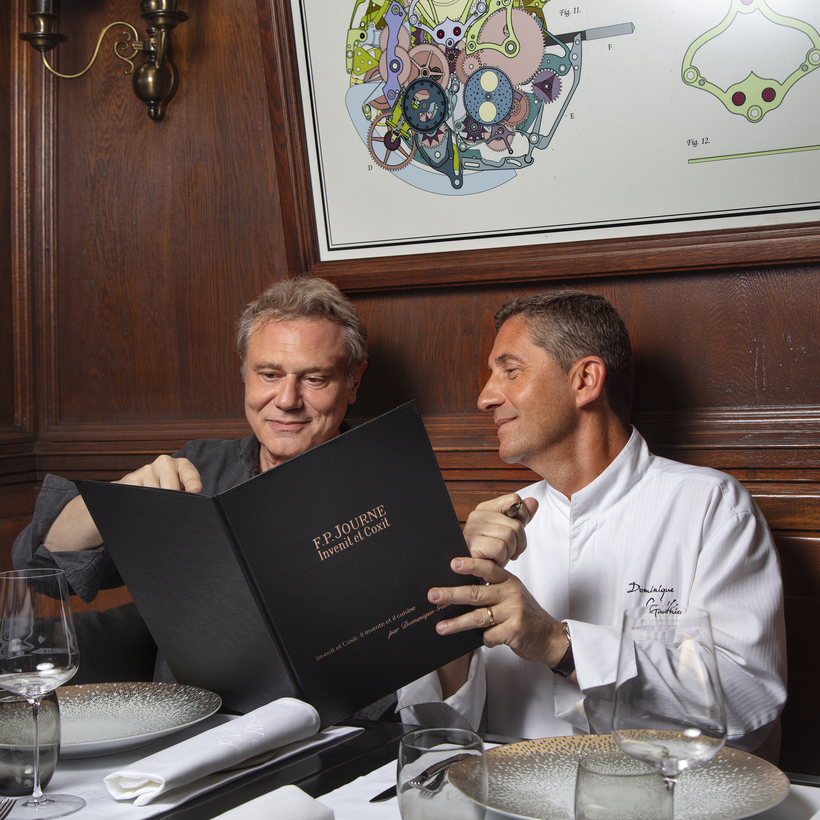One of the gifts of twenty-twenty hindsight is that those could-have-should-have and wished-I-would-have moments snap into unforgivingly sharp focus. A couple of years ago, I was reproaching myself for the Bitcoin that I did not buy, but the deflation of the crypto bubble has allowed a much older, more enduring regret to reassert itself—the fact that I never bought an F. P. Journe.
I remember once upon a time you could walk into a Journe shop and, mirabile dictu, purchase one of his new watches there and then. I also recall how they would crop up at auction frequently and affordably. Now you can wait up to a decade to buy a new one, or pay a six-figure sum for a pre-owned one. The problem with the former is that, at my age, I don’t know how long I have got, and the problem with the latter is that I know exactly how much I’ve got, and it is nowhere near enough.
Even a simple, time-only watch is inaccessible. Having seen one on the wrist of a friend, I tried to buy a green-dialed, green-strapped, three-hand platinum watch, but they are all sold out, and on the secondary market I was quoted a price of $175,000.

Still, at least for that you get a watch. A couple of years ago, someone paid a little more than $115,000 at auction for an F. P. Journe box. Yes, a box without a watch. Admittedly, it was a fancy box with slots for five watches, and some of the proceeds were destined for charity, but the message was loud and clear: not only can I not afford a watch, I can’t even run to a box.
All this bubbled to the surface when I was in Geneva last month, discharging my duties as jury president of the Grand Prix d’Horlogerie de Genève—usually described as the “Oscars of watchmaking” (although I prefer to describe the Academy Awards as the “G.P.H.G. of cinema”). Everyone was talking about François-Paul Journe.
He was not in the competition. (He has won the Aiguille d’Or, the ultimate award that the watch industry can bestow, on three occasions—more times than anyone else—as well as a fistful of other prizes.) He had not even launched a watch. His situation is analogous to those characters on the International Best-Dressed List for whom the Hall of Fame was created, in order to free up space for newcomers. Instead le tout Genève was all abuzz about the new F. P. Journe restaurant.
Not only can I not afford a watch, I can’t even run to a box.
Journe is not a watchmaker; he is a phenomenon. Having been writing about watches since the 1980s, which seems as distant as the Pleistocene era in terms of how far and how fast the market has come, I was around when Journe opened his eponymous Geneva atelier, which celebrates its 25th anniversary next year. Even if, stupidly, I did not buy the watches, I bought into the F. P. Journe story.

A native of Marseille, he was born in the late 1950s. During his teens, which coincided with his hometown’s French Connection years, he was a bit of a rebel. As François-Paul was not performing well in school, his parents did what parents do in these circumstances and enrolled him in a trade school—watchmaking, in his case. He loved it, but the school did not share his enthusiasm and expelled him after two years. However, by then the rebel had found his cause and his calling. He moved to Paris, where he enrolled in another watchmaking school and was apprenticed to an uncle who worked as a restorer of watches and clocks.
This was the crucial part of his formation. As an apprentice to a restorer, he was exposed to the work of the great watch- and clockmakers of the 18th and early 19th centuries. He learned that it was not enough just to restore the piece to working order; any repair had to be carried out in the way in which the maker would have done it.
“I discovered the intellectual process of brilliant minds from the 18th century—Janvier, Breguet, Berthoud, and a few others—by getting into the heart of their creations,” he once told me. Watchmakers who died a quarter of a millennium ago live on in his work, and his most intellectual pieces recall an age when watchmakers were not manufacturers of status-conferring, mechanical toys for the super-rich, but objects at the very sharpest point on the cutting edge of scientific research.

This imaginative inhabitation of the minds of long-dead watchmakers inspired his most renowned watch: the Chronomètre à Résonance. Both Janvier and Breguet researched the phenomenon of resonance, in which the vibrations of a moving object, the exciter, are picked up by another object, the resonator, which begins to vibrate at the same speed. There is obviously much more to it than that, but it is way above my head, although not François-Paul’s. He spent more than 15 years devising a watch in which two balance wheels working in close proximity, acting alternately as exciter and resonator, harmonize and improve the precision of the watch.
Visitors to his Geneva atelier are left in no doubt as to the importance of the past to his oeuvre; the main meeting room at his factory is named after Janvier and has a five-and-a-half-feet-tall resonance clock made by the 18th-century master.
But his true genius is that he is not an 18th-century watchmaker working in the 21st century, crafting a small number of high-concept timepieces for a small circle of highbrow collectors. Instead, he has managed the almost impossible tightrope walk of modern branding, and he participates in the world of super-fandom without compromising the intellectual content of his work.
Watchmakers who died a quarter of a millennium ago live on in his work.
You have the merchandise (baseball caps, pens, even a pair of F. P. Journe dolls—one representing a young F.P.J., the other a gray-haired version—each wearing little watches you can change) at one end, and at the other, the fact that this year Christie’s staged a single-brand auction devoted to Journe.
It really comes down to authenticity. Journe is unapologetically himself.
Which brings us back to his newly opened restaurant with chef Dominique Gauthier. While in Geneva, I sat down with both men and found what I can only call a true meeting of minds. I asked what had inspired Gauthier to move from a respected position as head chef at the Beau Rivage across the lake to run a brasserie downtown. His answer was simple.
“I met someone who is an artist, a creator, and who, if you like, has the rigor that chefs have. If you always want to make good food, you have to be very rigorous with your suppliers, with your products, with your employees. And I think that to make watches like he does, you have to have the same qualities.” To demonstrate a mission shared across horology and gastronomy, the menus carry the term “Invenit et coxit” (He invented it and cooked it), a reference to “Invenit et fecit” (He invented it and made it), which appears on the dials of Journe watches.

A magnificent 17th-century astronomical clock dominates one of the restaurant’s paneled walls, large diagrams of watch movements hang here and there, and each table bears a plaque featuring the name of a prominent watchmaker. Some are familiar (Hans Wilsdorf, founder of Rolex), others less so (Henri Motel, a marine-chronometer-maker in early-19th-century France). There is only one living watchmaker included—Journe himself.
The food is elegant without being pretentious; the roasted scampi with kadaif, citrus, and basil is worth a visit alone, and this being Switzerland, the cheese selection is an education. There is also a self-confidence that the two men share that reveals itself in subtle ways: “Egg from the Lignon farm” is described as “cooked to perfection.” And if you like the food, yes, there is F. P. Journe olive oil for sale to take home.
But the best thing about F. P. Journe Le Restaurant is you don’t have to wait 10 years to get a table.
Nicholas Foulkes, the author of more than 20 books on the arts and history, is a London-based writer and editor


